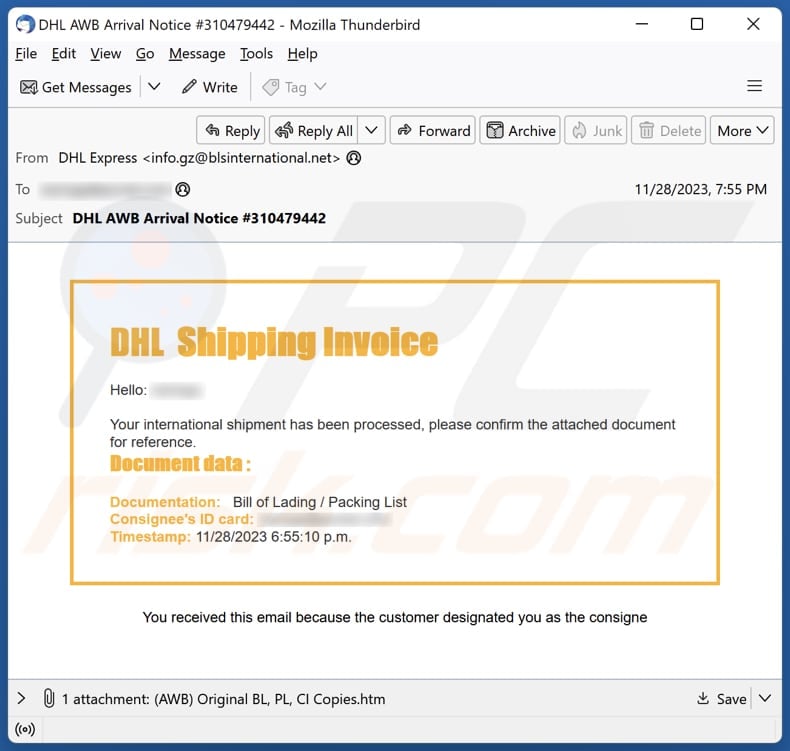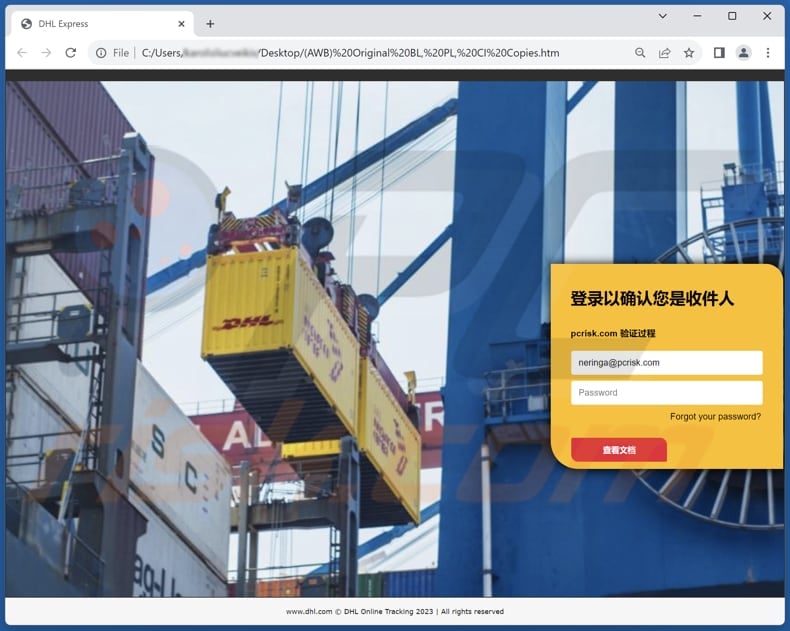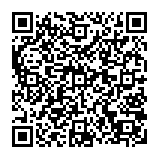How to identify scams like "DHL Shipping Invoice"
![]() Written by Tomas Meskauskas on
Written by Tomas Meskauskas on
What is "DHL Shipping Invoice"?
Upon meticulous examination, it has been identified that this email is a typical phishing attempt. Perpetrators orchestrating this phishing campaign masquerade as DHL, a reputable logistics company specializing in courier, package delivery, and express mail services. Their objective is to deceive recipients into divulging sensitive information through a fraudulent website.

More about the "DHL Shipping Invoice" scam email
The email claims that an international shipment has been processed, urging the recipient to confirm the attached document for reference. The document data allegedly includes a bill of lading, packing list, consignee's ID card number, and a timestamp. The message concludes by stating that the recipient received the email because the customer designated them as the consignee.
However, it is crucial to note that this email is a phishing attempt, with scammers posing as DHL to trick the recipient into interacting with the attached document, which leads to a fraudulent page aimed at extracting sensitive information.
The attached file in this email bears the name "(AWB) Original BL, PL, CI Copies.htm" (though its name might differ). This file harbors a counterfeit DHL login page, soliciting the recipient's email address and password. Any data entered on this page is transmitted to scammers, presenting the risk of potential misuse for various malicious purposes.
Scammers may target various types of accounts linked to the compromised credentials. This may include social media accounts, online banking, e-commerce platforms, and other web services. Scammers often engage in identity theft, using the acquired information to impersonate the victim and perpetrate fraudulent activities.
Furthermore, they might exploit the compromised credentials to access sensitive information stored in the victim's accounts, such as personal details, contact lists, and private messages. Unauthorized access to social media accounts could lead to the spread of misleading or malicious content, affecting the victim's reputation.
In cases where the victim uses the same password across multiple accounts, scammers may attempt to breach additional platforms, exacerbating the potential for financial loss and privacy invasion.
| Name | DHL Shipping Invoice Email Scam |
| Threat Type | Phishing, Scam, Social Engineering, Fraud |
| Fake Claim | International shipment has been processed |
| Attachment | (AWB) Original BL, PL, CI Copies.htm |
| Detection Names (Attachment) | Avast (HTML:Phishing-CTV [Phish]), Combo Cleaner (Trojan.HTML.Phishing.CAZ), ESET-NOD32 (HTML/Phishing.Gen), Ikarus (Phishing.HTML.Doc), Symantec (Trojan.Gen.NPE), Full List Of Detections (VirusTotal) |
| Disguise | Letter from DHL |
| Symptoms | Unauthorized online purchases, changed online account passwords, identity theft, illegal access of the computer. |
| Distribution methods | Deceptive emails, rogue online pop-up ads, search engine poisoning techniques, misspelled domains. |
| Damage | Loss of sensitive private information, monetary loss, identity theft. |
| Malware Removal (Windows) | To eliminate possible malware infections, scan your computer with legitimate antivirus software. Our security researchers recommend using Combo Cleaner. |
Similar scam emails in general
Phishing emails typically share common characteristics, including deceptive content, urgent or alarming language, imitation of trusted entities, and a request for the recipient to click on malicious links or provide sensitive information. They often exploit social engineering tactics to manipulate recipients into taking actions that compromise their security.
Examples of fraudulent emails aimed at extracting personal details are "Your Encrypted Voice Message", "Maersk Line", and "ACH-ELECTRONIC FUNDS TRANSFER". Users must be aware that files and links in emails sent by threat actors can be used to deliver malware.
How do spam campaigns infect computers?
Users can unwittingly compromise their computers through email by falling victim to various tactics employed by cybercriminals. One common method involves malicious attachments, often disguised as innocuous files like ".zip", ".exe", ".js", ".pdf", ".doc", etc. When users open these attachments, malware can be unleashed, infiltrating the system and potentially leading to various security threats.
Another avenue for infection is through deceptive links embedded in emails. Clicking on these links can direct users to malicious websites designed to exploit vulnerabilities in their browsers or download malware directly to their devices.
How to avoid installation of malware?
Avoid opening attachments or clicking on links from unfamiliar or unexpected sources, as these can be potential vectors for malware. Regularly update the operating system and software (including a security solution). Install reputable antivirus or anti-malware software to defend against various online threats.
Avoid suspicious websites, advertisements, links, and pop-ups, and refrain from downloading software from untrustworthy sources (e.g., P2P networks or third-party downloaders). Lastly, never download pirated software, cracking tools, and key generators to bypass paid software activations.
If you have already opened malicious attachments, we recommend running a scan with Combo Cleaner Antivirus for Windows to automatically eliminate infiltrated malware.
Text presented in the "DHL Shipping Invoice" email letter:
Subject: DHL AWB Arrival Notice #310479442
DHL Shipping InvoiceHello: ********,
Your international shipment has been processed, please confirm the attached document for reference.
Document data :Documentation: Bill of Lading / Packing List
Consignee's ID card: ********
Timestamp: 11/28/2023 6:55:10 p.m.
You received this email because the customer designated you as the consigne
Phishing page presented in this scam email:

Instant automatic malware removal:
Manual threat removal might be a lengthy and complicated process that requires advanced IT skills. Combo Cleaner is a professional automatic malware removal tool that is recommended to get rid of malware. Download it by clicking the button below:
▼ DOWNLOAD Combo Cleaner
By downloading any software listed on this website you agree to our Privacy Policy and Terms of Use. To use full-featured product, you have to purchase a license for Combo Cleaner. 7 days free trial available. Combo Cleaner is owned and operated by Rcs Lt, the parent company of PCRisk.com read more.
Quick menu:
- What is DHL Shipping Invoice phishing campaign?
- Types of malicious emails.
- How to spot a malicious email?
- What to do if you fell for an email scam?
Types of malicious emails:
![]() Phishing Emails
Phishing Emails
Most commonly, cybercriminals use deceptive emails to trick Internet users into giving away their sensitive private information, for example, login information for various online services, email accounts, or online banking information.
Such attacks are called phishing. In a phishing attack, cybercriminals usually send an email message with some popular service logo (for example, Microsoft, DHL, Amazon, Netflix), create urgency (wrong shipping address, expired password, etc.), and place a link which they hope their potential victims will click on.
After clicking the link presented in such email message, victims are redirected to a fake website that looks identical or extremely similar to the original one. Victims are then asked to enter their password, credit card details, or some other information that gets stolen by cybercriminals.
![]() Emails with Malicious Attachments
Emails with Malicious Attachments
Another popular attack vector is email spam with malicious attachments that infect users' computers with malware. Malicious attachments usually carry trojans that are capable of stealing passwords, banking information, and other sensitive information.
In such attacks, cybercriminals' main goal is to trick their potential victims into opening an infected email attachment. To achieve this goal, email messages usually talk about recently received invoices, faxes, or voice messages.
If a potential victim falls for the lure and opens the attachment, their computers get infected, and cybercriminals can collect a lot of sensitive information.
While it's a more complicated method to steal personal information (spam filters and antivirus programs usually detect such attempts), if successful, cybercriminals can get a much wider array of data and can collect information for a long period of time.
![]() Sextortion Emails
Sextortion Emails
This is a type of phishing. In this case, users receive an email claiming that a cybercriminal could access the webcam of the potential victim and has a video recording of one's masturbation.
To get rid of the video, victims are asked to pay a ransom (usually using Bitcoin or another cryptocurrency). Nevertheless, all of these claims are false - users who receive such emails should ignore and delete them.
How to spot a malicious email?
While cyber criminals try to make their lure emails look trustworthy, here are some things that you should look for when trying to spot a phishing email:
- Check the sender's ("from") email address: Hover your mouse over the "from" address and check if it's legitimate. For example, if you received an email from Microsoft, be sure to check if the email address is @microsoft.com and not something suspicious like @m1crosoft.com, @microsfot.com, @account-security-noreply.com, etc.
- Check for generic greetings: If the greeting in the email is "Dear user", "Dear @youremail.com", "Dear valued customer", this should raise suspiciousness. Most commonly, companies call you by your name. Lack of this information could signal a phishing attempt.
- Check the links in the email: Hover your mouse over the link presented in the email, if the link that appears seems suspicious, don't click it. For example, if you received an email from Microsoft and the link in the email shows that it will go to firebasestorage.googleapis.com/v0... you shouldn't trust it. It's best not to click any links in the emails but to visit the company website that sent you the email in the first place.
- Don't blindly trust email attachments: Most commonly, legitimate companies will ask you to log in to their website and to view any documents there; if you received an email with an attachment, it's a good idea to scan it with an antivirus application. Infected email attachments are a common attack vector used by cybercriminals.
To minimise the risk of opening phishing and malicious emails we recommend using Combo Cleaner Antivirus for Windows.
Example of a spam email:

What to do if you fell for an email scam?
- If you clicked on a link in a phishing email and entered your password - be sure to change your password as soon as possible. Usually, cybercriminals collect stolen credentials and then sell them to other groups that use them for malicious purposes. If you change your password in a timely manner, there's a chance that criminals won't have enough time to do any damage.
- If you entered your credit card information - contact your bank as soon as possible and explain the situation. There's a good chance that you will need to cancel your compromised credit card and get a new one.
- If you see any signs of identity theft - you should immediately contact the Federal Trade Commission. This institution will collect information about your situation and create a personal recovery plan.
- If you opened a malicious attachment - your computer is probably infected, you should scan it with a reputable antivirus application. For this purpose, we recommend using Combo Cleaner Antivirus for Windows.
- Help other Internet users - report phishing emails to Anti-Phishing Working Group, FBI’s Internet Crime Complaint Center, National Fraud Information Center and U.S. Department of Justice.
Frequently Asked Questions (FAQ)
Why did I receive this email?
Fraudsters dispatch identical letters to a multitude of individuals, anticipating that someone among the recipients will succumb to their scheme. These unsolicited emails lack any personalization.
I have provided my personal information when tricked by this email, what should I do?
If you have fallen victim to a phishing scam and disclosed your email address and password for the affected account (or accounts), immediately change your password, enable two-factor authentication (if possible), and inform the relevant platforms of the incident.
I have downloaded and opened a file attached to this email, is my computer infected?
While the attachment in this email does not contain malware, be cautious. Opening files or clicking links in such emails can still pose a risk of computer infections.
I have read the email but did not open the attachment, is my computer infected?
Simply opening an email is harmless. Cybercriminals cannot succeed without users opening links or attachments.
Will Combo Cleaner remove malware infections that were present in email attachment?
Combo Cleaner has the ability to find and remove nearly all recognized malware. It is important to note that sophisticated malware can conceal itself deeply within the system. Therefore, performing a full system scan is essential.


▼ Show Discussion